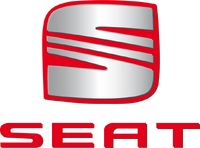 | |
| Type | Private company, Subsidiary of Volkswagen Group, member of the Audi Brand Group |
|---|---|
| Predecessor | Sociedad Ibérica de Automóviles de Turismo (S.I.A.T.) |
| Founded | May 9th 1950 |
| Founder(s) | Instituto Nacional de Industria |
| Headquarters | Martorell, Spain |
| Number of locations |
Martorell, Spain Zona Franca, Spain El Prat, Spain |
| Area served |
Europe, Africa, Americas, Asia |
| Key people |
James Muir Chairman of SEAT's Executive Committee Luc Donckerwolke SEAT Design Director |
| Industry | Automotive |
| Products | Cars |
| Services | design, manufacture and distribution of SEAT and other Volkswagen Group cars and components |
| Employees | 11,010 (2008) |
| Parent | Volkswagen Group |
| Divisions | SEAT Sport |
| Website | SEAT.com |
SEAT, S.A. (English pronunciation: /ˈseɪ.æt/ SAY-at, Spanish: [ˈse.at]), commonly known as SEAT, is a Spanish automobile manufacturer founded on May 9, 1950 by the Instituto Nacional de Industrial (INI) of Spain, currently a wholly owned subsidiary of the German Volkswagen Group [2] as a member of the now-defunct Audi Brand Group, together with Audi and Lamborghini,[3][4] and marketed as a car maker with a youthful sporty profile.[5][6] Within the Volkswagen Group and under the Audi Brand Group, the SEAT brand itself has been developed as a group with subsidiary companies (SEAT Group) and 'SEAT, S.A.' as the parent company.[7]
The headquarters of SEAT, S.A. are located at SEAT's industrial complex in Martorell near Barcelona, Spain. By 2000 annual production peaked at over 500,000 units; in total up to 2006, over 16 million cars have been produced [8] including more than 6 million from the Martorell plant,[4] with three-quarters of the annual production being exported to over seventy countries worldwide.[9]
The name SEAT, previously standing for the acronym Sociedad Española de Automóviles de Turismo (Spanish Touring Car Company, in English), in 1990 was changed to SEAT, S.A..[4]
Facilities[]
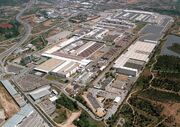
SEAT's industrial complex in Martorell
SEAT today is the only major Spanish car manufacturer with the ability and the infrastructure to develop its own cars in-house.[10]
Its headquarters and main manufacturing facilities are located in Martorell, an industrial town located some 30 kilometres northwest of Barcelona,[11] with a production capacity of around 500,000 units per annum.[12] The plant was opened by King Juan Carlos of Spain on February 22, 1993, and replaced SEAT's former assembly plant by the coast in Barcelona's freeport zone (Zona Franca). A rail connection between SEAT's Martorell and Zona Franca complexes facilitates vehicle and parts transportation between the two sites.[13]
The industrial complex in Martorell also hosts the facilities of SEAT Sport,[14] SEAT's Technical Center, Research and Development Center (R&D),[15] Design Center,[16] Prototypes Centre of Development,[17] SEAT Service Center (also incorporating the After-Sales Service division, the Customer Services division and the Catalunya Motor dealership),[18] as well as the Genuine Parts Centre for SEAT, Volkswagen, Audi and Škoda brands.[19]
The development and assembly facilities are some of the newest and most modern and efficient within the Volkswagen Group, giving the SEAT Martorell site the ability to produce high-quality cars[20] not only for its own brand but also for other Volkswagen Group brands, such as Volkswagen and Audi.[21] For example, the development and design of several Audi models (e.g. the Audi A1,[22] the Audi A3 Sportback,[23] the Audi Q5 etc.) and also several Audi development projects took place there,[24] and from 2011 onwards the Martorell plant will manufacture the Audi Q3 small SUV.[25]
The Barcelona Zona Franca site includes the SEAT Training Centre,[26] the Zona Franca Press Shop factory, producing stamped body parts, and the Barcelona Gearbox del Prat plant, producing gearboxes not only for SEAT but also for other Volkswagen Group marques (VW, Audi and Škoda);[27] the latter plant was awarded the Volkswagen Excellence Award in 2009 by the Volkswagen Group for high-quality production process and product.[27]
Another plant owned directly by SEAT from 1975[28] was the Landaben plant in Pamplona, but on December 1993 its ownership was transferred to the Volkswagen Group subsidiary "Volkswagen-Audi-Espana, S.A.",[29] and the site today is producing Volkswagen cars in Spain.[30] However, SEAT's Martorell site still provides support to Volkswagen's operations in the Pamplona plant when necessary, as it did after a serious fire in the paint shop in the Landaben VW plant in April 2007.[31]

SEAT's Pavilion at Autostadt, Wolfsburg
Factories of the Volkswagen Group currently producing SEAT models also include the Palmela AutoEuropa site in Portugal,[4] while in the past other plants were involved too in producing SEAT models, such as the factories in Germany (Wolfsburg), Belgium (Brussels) and Slovakia (Bratislava).[32]
Future plans include a new Research and development (R&D) centre in the city of Barcelona in the field of environmental and energy efficiency for the entire Volkswagen Group and also the launch of a project on the city's urban mobility,[33] as well as a SEAT museum in the Zona Franca's 'Nave A122' site hosting all production and prototype models ever presented by SEAT together with some special or limited edition vehicles with historical value for the brand and the automotive history of Spain.[34][35]
Among SEAT's subsidiaries, the SEAT Deutschland GmbH subsidiary company is based in Mörfelden-Walldorf, Germany, and apart from its commercial activities has the further responsibility of operating SEAT's electronic platform, the SEAT IT Services Network.[36] In Wolfsburg, Germany, in the middle of a lake inside the Autostadt, the Volkswagen Group's corporate theme park,[37] is SEAT's thematic pavilion, one of the largest pavilions in the park.[38]
Presence in different markets[]
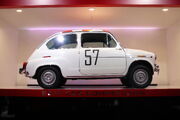
SEAT 600, the first model exported by SEAT in 1965 to Colombia, became the best-selling car in Finland from 1970 to 1973
In its 60 years, there was only a short period from 1953 to 1965 when the firm produced its cars exclusively for the domestic Spanish market. In 1965 and in a rather symbolic move, the company exported some 150 units of its SEAT 600 model destined for Colombia by air freight for the first time, until two years later in 1967 SEAT reached a deal over the renegotiation of its licence contract with Fiat which allowed the Spanish firm to form an international distribution network for its cars and thereafter start its export operations massively to more than twelve different countries, entering the export market in 1969.
Today, the company launches its own models of cars in different markets in more than 70 countries worldwide in accordance with the development policies of the Volkswagen Group, with almost three-quarters of its annual production representing exports for the markets out of Spain. Its core market remains Europe, while the most successful market outside of Europe in terms of sales for SEAT is currently Mexico, where the company has dealer presence in 27 Mexican states.[39]
In Europe the brand is launched in almost 40 countries across Northern, Western, Southern, Eastern Europe and Russia. SEAT today also sells its cars in 11 countries in Asia, mostly in the Middle East and the Arabian peninsula, in 16 countries in Americas including North America, the Caribbean Sea, Central America and South America, and finally Africa, mainly in North Africa. Some of its cars have been sold outside Europe, branded as Volkswagens, such as the SEAT Ibiza hatchback, known in South Africa as the Volkswagen Polo Playa, the SEAT Inca panel van as the Volkswagen Caddy, or the SEAT Córdoba, also known as the Volkswagen Polo Classic.
In the years to come SEAT plans expanding in even more markets, the most crucial of them all being China.[40] While in the past SEAT hold talks with the Chinese car maker FAW in order to form an alliance for the local production of SEAT models in China-located plants, the present project to enter the Chinese market comprises in 2012 first to start selling its range with cars produced in SEAT's Spain-located Martorell plant, followed later in a second phase by the local assembly of SEAT models in China.[41]
SEAT's further expansion plans in more markets outside of Europe have yet to be realised. In the past the company was considering a possible launch in the United States although this move has never been carried out.[42] Rumours also of a SEAT model being sold as a Volkswagen in Canada and the United States to supplement the Volkswagen's brand lineup there have occasionally circulated, but have always been unsubstantiated, and ultimately proven to be false.
In the past other market areas where the brand was also present for a short time were Australia and New Zealand (from 1995 to 1999) as well as South Africa (from June 2006 to the end of 2008), however the brand was withdrawn from those markets due to a Volkswagen's decision citing that current and expected circumstances made the ongoing importation of a niche brand non-viable.[43][44]
History[]
Establishment of SEAT[]
Spain today is the world's eighth largest producer of automobiles[45][46] and its car market stands among the largest in Europe. However this has not always been the case for the country: for the greatest part of the first half of the twentieth century the limited car production in Spain's already respectively small market had been taken over mostly by foreign subsidiaries either importing or assembling cars in their local plants, depriving the country of technological know-how and substantial investments which could boost the economy. After the end of the Spanish Civil War in 1939 the situation deteriorated, as not only the car demand collapsed due to the reduced purchasing power affected by the skirmishes but also the multinational subsidiaries either ceased operations, departed the country and disappeared from the scene or were severely stricken during the warfare and therefore weakened they were struggling to continue business.[47]
Into that groundfield flourished an opportunity and demand for the nation's volume car maker[48]: SEAT dates its origins back to June 22, 1940 when the private Spanish bank 'Banco Urquijo' with the support of its group of industries (Hispano-Suiza, Basconia, Duro-Felguera, S.E. de Construcción Naval, Euskalduna, S.E. de Construcciones Metálicas, Fundiciones Bolueta, Echevarría etc) founded SEAT's predecessor company, the 'Sociedad Ibérica de Automóviles de Turismo' (S.I.A.T.) with an ambitious goal, that of being established as Spain's national car maker. The initial Banco Urquijo's project was aiming at running the S.I.A.T. motor company as a fully private enterprise, but soon after the foundation in 1941 of the interventionist state holding company Instituto Nacional de Industria (INI) the whole project would be taken over and carried out under the INI's leadership following a decision taken on January 3, 1942.[49] The vision the new conglomerate carried on for the upcoming national car brand was not the one of another licensee car maker just assembling in Spain car models from some foreign manufacturer, it was instead the one serving the much needed autarky keeping the whole manufacturing process in Spain but most important being able gradually to produce its own specific models with locally made parts. In acknowledgement of the country's lack of extended previous expertise in automobile developing procedures, the intention was to invite a recognized foreign partner automobile maker who would contribute technically and with its own models in the start - giving to him in exchange cash, shares, bonds and royalties - but who would over time step aside as soon as the Spanish national car maker would become more and more independent and eventually capable to produce its own range of vehicles. With the rest of Europe though having entered the World War II, the project was consequently delayed but not abandoned due to its strategic importance.
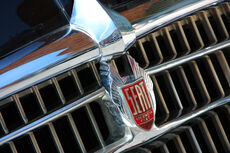
SEAT's first emblem
SEAT under its current name was founded on May 9, 1950 under the denomination 'Sociedad Española de Automóviles de Turismo, S.A.' (S.E.A.T.) by the Instituto Nacional de Industria (INI) with a starting capital of 600 million Pesetas - equivalent today of almost 3.6 million Euros - in the form of 600 thousand shares of one thousand Pesetas each, and in a time when the country was in need of remodelling the fundamental structures in its national economy, just after the end of the World War II. The birth of SEAT came almost a year and a half after the Spanish government and six Spanish banks ( 'Banco Urquijo', 'Banco Español de Crédito (Banesto)', 'Banco de Bilbao', 'Banco de Vizcaya', 'Banco Hispano-Americano' and 'Banco Central' ) [50] had signed on October 26, 1948 an alliance contract with the Italian car manufacturer Fiat so as to form a partnership with a foreign ally in order to bring to life Spain's major car manufacturer.[51] Among all the bidders the German Volkswagen and the Italian Fiat were the predominant ones, however the Italian firm Fiat proved to be the alleged ally for several reasons: first, Fiat was a car manufacturer already known in Spain for its built quantities aptitude relevant to that prospected for SEAT and also had attributed a successful outcome of collaboration in the endeavor of the French Simca; second, the experience from the semi-protected car market in Italy could easily be transferred to the one in Spain, both of which had, at the time, customers of low incomes and limited markets for cars. Fiat's experience in the very similar market conditions of Italy made it the best choice for a partner in Spain. Fiat had been granted a monopoly in Italy, it dominated the market for vehicles under 12 horsepower; also, the relative economic isolation of war damaged Italy at the end of the World War II and the fact that the Italian car maker was looking to opportunities outside Italy in the post World War II (the short-lived 'Fiat Hispania' 's plant in Guadalajara, having been destroyed by the Spanish Civil War) - meant that the negotiations with the Italian manufacturer could prosper more easily in favour of Spanish interests than with those from other countries. In 1947 the Banco Urquijo group had revived the S.I.A.T. project and next year the talks ended up successfully in the signing of the three-part contract, with the understanding that the INI would hold the 51% controlling interest as well as a ruling act in the new company preserving to stay focused on the approach of an enterprise of 'national interest', Banco Urquijo group although a minority share holder looking forward in assuming a leading role in the future as soon as the company would be left to privates and the newcomer partner car maker Fiat been offered a 7% share in exchange of its technical assistance. This way SEAT not only would be able to reinitiate the country's economy as the largest employer in the 1960s and 1970s but also contribute to the industrialisation of a then still largely rural society.
Even though there were initial thoughts of locating in less developed inland cities like Valladolid and Burgos, it was decided that the company's plant would be constructed in the duty-free zone area of the Port of Barcelona (Barcelona Zona Franca), which would offer better access to the Mediterranean shipping and the rest of Europe through rail and road connections across the nearby French border. Barcelona was a city with an industrial history that had built up expertise in complex industrial enterprises since the latter part of the 19th century; it was also the location of the early Spanish car makers, Hispano-Suiza and Elizalde, and subsidiearies of foreign car makers, Ford Motor Ibérica and General Motors Peninsular. Being an enterprise of vital interest for the national economy as well as an investment opportunity for Fiat's expansion plans through the Iberian peninsula, SEAT benefitted from state tariff and tax exemptions and technical assistance from FIAT. The company’s first president was José Ortiz Echagüe, an aeronautical engineer who came from the Spanish aircraft builder 'CASA', where he had held the position of CEO.
Partnership with Fiat[]
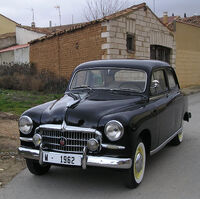
SEAT 1400, the first model produced by SEAT in 1953
The construction works for SEAT's Zona Franca plant began on 1950 and the opening day came three years later on June 5, 1953, while in the meantime since 1951 the Spanish marque was starting preparations for setting up almost from scratch an entire supplier industry background. The first car in the marque's history to be produced was a SEAT 1400 model that came off the production line on November 13, 1953 with licence plate 'B-87.223'. In the following few months the plant's production output and workforce would significally increase together with the implementation of locally made components in the production process, in order to limit imports from one part and from another part to push to the development of the almost non-existent Spanish supplier industry and meet SEAT's assigned key role as the national car maker in restoring the Spanish economy of the post World War II Spain. Already from 1954 the use of Spanish-made parts had raised up to a 93% proportion out of total and next year on May 5, 1955 the factory was officially opened.
Until the time SEAT had the technical maturity and expertise to present its first self-developed model the SEAT 1200 Sport in 1975, in its beginnings the company had to manufacture either rebadged or restyled models borrowed from the range of its Italian partner Fiat, or even redeveloped them according to the needs of its own range. However the first example of a SEAT exclusive derivative would arrive already on September 1963 with the launch of the SEAT 800, a car which was developed in-house by SEAT with no equivalent model in Fiat's range on the basis of the SEAT 600 as a stretched version with 4-doors.
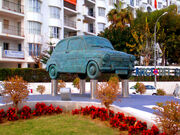
A monument in Spain for the SEAT 600, the car symbol of the Spanish miracle[52][53]
In 1957 SEAT founded the SEAT Training Centre in the greater Zona Franca plant area, an institution covering the training of qualified personnel and serving the needs of the automobile industry in specialized technical human resources.[54] In that same year was launched the historical SEAT 600, which proved to be the crucial car that literally motorized Spain, being the first car for many Spanish families and becoming a symbol of the Spanish Miracle.
As the growth of the annual production was hitting one record after another due to the heavy demand, the economies of scale achieved would permit cutting costs and prices, subsequently renew demand and boost sales together with profits for SEAT. On June 29, 1964, the brand opened its new headquarters in Madrid, which hosted the firm's sole - up to 1972 - general administration offices. In Barcelona was found only SEAT's plant manager until 1973, a year when SEAT settled in Catalonia another general direction.
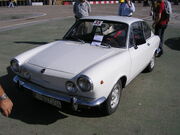
SEAT 850 Sport, launched in 1967,
it was the first coupé model from SEAT
In 1967, fourteen years after producing cars for the domestic market, SEAT's success would be signalised by a dominant position in Spain ahead of its major competitors, i.e. 'FASA-Renault', 'Citroën-Hispania', Authi and Barreiros, making SEAT the Spain's largest auto-maker in sales numbers and a wholly localized production. In that year an agreement between Fiat and the Spanish Ministry of Industry was reached so as to put an end in the restrictions over exporting SEAT cars out of Spain, a term previewed in the original licencee contract with Fiat since 1948. In exchange to that, Fiat would increase its holding in the company from 7% to 36%, and at the same time the share held by the government holding agency would be reduced from a controlling 51% to 32%. The remaining 32% was taken by the six major Spanish banks, decreased from their previous 42% share split equally in 7% parts owned by every single one of them. Although not a majority owner, Fiat now was seen to control the business: the deal also included various undertakings by Fiat to help in the growth of SEAT, and with the development of a new model (possibly the SEAT 133).[55] On December 6, 1967, SEAT also founded its own customer financing company 'Financiera SEAT, S.A.' (Fiseat).
To be able to produce independently its own research projects, SEAT on November 16, 1970 came in accordance with Fiat so as to start building separate infrastructures aiming at developing new technologies. As the brand arranged in 1972 some provisional facilities in the site of the future Technical Center in Martorell and in 1973 began construction works, this goal would only take five years till 1975 to be reached with the completion of the first phase in the construction of SEAT's Technical Center, a facility designed by the Catalan architect Josep Antoni Coderch.[56]
During the same period, the manufacturer continued to dominate the Spanish auto market, producing 282,698 cars - more than 58% of the Spanish production total - in 1971 despite disruption that year caused by strikes and a serious flood at the coastally sited Barcelona plant.[57] However, with just 81 cars per thousand people, Spanish car sales were seen as ripe for further growth, and SEAT faced the prospect of increased competition with other major manufacturers contemplating establishment or expansion of 'local' production facilities in the still heavily protected Spanish car market.[57]
In 1973, SEAT and 'Citroën-Hispania' jointly contributed equal shares in founding the Vigo-located factory of 'Industrias Mecánicas de Galicia, SA' (Indugasa) producing constant-velocity joints, essential components used in front-wheel drive cars i.e. in a transmission layout the use of which was becoming more and more common at the time. This plant - which in the next years would supply parts not only to SEAT and 'Citroën-Hispania' but also to 'Ford España' - was meant to be transferred later in 1986 to the multinational company GKN.[58]
On May 1975, after a request from the Spanish state authorities to ensure the rescue of the jobs for the workers in the Authi owned factories, SEAT moved on talks with the parent company British Leyland Motor Corporation (BLMC) of the bankrupt Authi in order to take over the brand's operations in Spain leaving aside GM's interest in it, something which would otherwise open the path for the American automaker to enter the Spanish market thus jeopardizing the relationship with Fiat. The talks ended soon on July 1975, when an agreement was announced between the two parts under which SEAT would acquire from BLMC the Authi brand along with its assets for 1,250 million pesetas. The imposed acquisition of the Landaben plant would also result in giving up SEAT's plans to build a new facility in Saragossa. Although the Authi supplier factory in Manresa was transferred to a company called Cometsa for 150 million pesetas, the Landaben plant in Pamplona remained under SEAT's ownership to continue production on February 1976 only of SEAT cars this time.[59][60]
The 1970s were a decade of rising prosperity in Spain, which is reflected in the announcement in August 1976 that SEAT would commence local production of the Lancia Beta.[61] Three years later Beta production by SEAT indeed commenced at the company's recently acquired Pamplona plant, though only the Coupe and HPE lift-back versions were included. The Spanish cars were fitted with a simplified suspension system and smaller engines than their Italian counterparts in order to qualify for a lower car tax rate.
In 1977 SEAT's leasing company Liseat was founded and in 1979 the Gearbox del Prat facility was set up as a specialised plant in the production of gearboxes, gear mechanisms and differentials in El Prat del Llobregat near Barcelona.
Dispute with Fiat[]
In the early 1980s extensive discussions concerning funding and control took place between the major share holder, the Spanish government, and Fiat: SEAT needed major capital investment which Fiat was not prepared to inject partly due to the oil crisis of the '70s and in another part due to the uncertainty for Fiat's interests following the end of a protectionist policy against GM in Spain. The outcome, by 1982, was an end after nearly 30 years, to the relationship with Fiat, a rather surprising decision in spite of the favourable perspectives for the Spanish economy with Spain being in the anteroom of the European Economic Community since 1977.
The end of the co-operation with the Italian firm was marked by a change in SEAT's logo in 1982, and the first car under the new SEAT logo without Fiat involvement appeared in 1982, called the SEAT Ronda styled by Rayton Fissore in collaboration with the Technical Centre in Martorell. The launch of this model though sparked a lawsuit from Fiat against SEAT, as the former claimed the car was too similar to a car in Fiat's range, the Fiat Ritmo. In defence of SEAT, the then president of SEAT, Juan Miguel Antoñanzas, showed a Ronda to the press with all the parts different from the Fiat Ritmo painted in bright yellow, to highlight the differences. The case was eventually taken to the Arbitration Chamber of Paris which in 1983 declared that differences between both cars were important enough so as not to consider the Ronda as a rebadged Ritmo, ending the dispute in favour of SEAT. Rumour at the time had it that Fiat was angry because the Ronda restyling was in fact too close to their own planned restyling for the Fiat Ritmo, which they had to scrap.
Volkswagen Group subsidiary[]
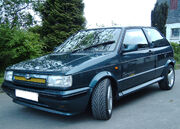
SEAT Ibiza Mk1, launched in 1984,
it was the first model developed by SEAT as an independent company, together with Porsche and Karmann
In 1982, Dr. Carl Horst Hahn - who had just assumed responsibility as the chairman of the Volkswagenwerk AG (Volkswagen Group) - looked into the opportunity of approaching SEAT after the withdrawal of Fiat in 1981, in his plan to expand the Volkswagen Group's operations out of Germany and turning the German group into a global force. The Spanish authorities had though already started talks with other foreign firms such as Toyota,[62] Nissan and Mitsubishi[63] in order to choose a strong partner for SEAT. However it was Hahn's interest that would soon result in an industrial and commercial cooperation as well as a licence agreement with SEAT on September 30, 1982 for the production in Spain of the Volkswagen Passat-Santana and Polo-Derby models in SEAT's Zona Franca and Landaben factories respectively [64] - having thus as an effect on April 29, 1983 the ending of the SEAT Panda's production at the Landaben assembly lines due to need of adapting this plant to the production of the VW Polo - and eventually a partnership agreement was signed on June 16, 1983 between the two parts being represented by the president of SEAT Juan Miguel Antoñanzas and Carl Hahn on behalf of the Volkswagenwerk AG.[65]
On June 18, 1986 after a purchase of SEAT's 51% majority stake followed later that year on December 23, 1986 by the increase of its share up to 75%, the Volkswagen Group became the major shareholder of SEAT, and as of December 1990 the 99,99% owner of the company thus making SEAT the first non-German subsidiary of the Volkswagen Group. Fulfilling Hahn's expectations, SEAT not only made a profit two years after Volkswagen bought a majority of its stock but also provided a low-cost manufacturing outlet for other VW group models - contributing up to 15.2% of the VW group's total output in 1989 - as well as an opportunity to enter the unexploited by that time Spanish market under the SEAT, VW and Audi brand names.
The gathering of the brand's main infrastructures in the greater Martorell plant area has taken place in a long process beginning back in 1975 with the opening of the SEAT Technical centre [66] but it was only in 1989 when a decision was taken to start building a new main assembly facility next to the Technical Centre in Martorell replacing the old one in Zona Franca. In that same year began the translocation of SEAT's Madrid admiistration offices to Barcelona with the sale of two of the brand's assets in La Castellana to be completed in 1991 with the definitive installation of SEAT's headquarters in the Catalonia's capital city.

SEAT Toledo Mk1, launched in 1991,
it was the first model fully developed under Volkswagen group's ownership
The centralisation of the management, design, research and production facilities localized around the plant site was meant to serve the aim of optimising the development in the process of making new models. On February 22, 1993 King Juan Carlos of Spain and the newly elected since January 1, 1993 Chairman of the Volkswagen Group Ferdinand Piëch inaugurated the Martorell plant, one of the most modern and efficient car plants in Europe using the 'Just in time' process with its suppliers’ site located only 2.5 km away. The first cars that rolled out of the Martorell plant production lines were the SEAT Ibiza Mk2 and the SEAT Córdoba Mk1.
The original planning in October 1993 to close the emblematic Zona Franca assembly plant as soon as the production of vehicles would be transferred to the more efficient Martorell plant was overturned after an arrangement between the Spanish authorities and the Volkswagen Group, according to which the Zona Franca site would continue its operations but would be gradually turned into a site with an auxiliary role in the production process (foundry, press-shop etc.). Meanwhile on December 23, 1993, the 'Fábrica Navarra de Automóviles, S.A.' was founded as a new company to hold the management of the Landaben factory separating any ties to SEAT in production matters, with its shares being transferred to Volkswagen on June 1994 over which however SEAT would regain ownership four years later in 1998.
In 1994 the Design Center in Sitges [67] - the Spanish coastal town south of Barcelona - and the suppliers' park in Zona Franca were also inaugurated, and in winter of the same year SEAT's financing and leasing companies - Fiseat and Liseat - were sold to 'Volkswagen Financial Services AG'.
The first time a SEAT model was manufactured out of Spain was in 1996, with the production of the SEAT Alhambra Mk1 in the Palmela AutoEuropa plant in Portugal. Also on January 1997 it was the first time when a non-Spanish descendant, the Belgian Pierre-Alain de Smedt, was ever appointed SEAT's chairman.
On April 7, 1998 the Zona Franca plant marked the end in the production life cycle of the Marbella model, signalising an historical moment for SEAT with the end of vehicle production in SEAT's oldest factory opened in 1953; ever since the Zona Franca plant produces components and parts to be assembled in other locations.
In March 1999 at the Geneva Motor Show, SEAT presented a modern stylised logo, more rounded compared to the last one and with the use of the silver colour on a red background - instead of the previous blue - symbolising respectively the rational and the emotional. The 'auto emoción' slogan was presented next year in September 2000 reflecting the brand's new youthful and sporty corporate identity, while SEAT Sport apart from its motorsport activities would undertake the responsibility of developing SEAT's high performance vehicles.
Next year on July 1, 2000 Dr. Bernd Peter Pischetsrieder, the former Chief Executive Officer of BMW, was appointed to head SEAT. In the spring of 2002 as Pischetsrieder was commissioned to chair the entire Volkswagen Group, he gave way to his German compatriot Andreas Schleef on March 7, 2002.
From 2002 up to 2007 SEAT formed part of the Audi Brand Group, the Volkswagen Group's automotive sub-division, consisted of Audi, SEAT and Lamborghini, that was focused on more sporty values, with the marque's product vehicles and performance being under the higher responsibility of the Audi brand.[68][69]
In 2006 the new SEAT corporate head office was opened in Martorell and the Martorell SEAT Design Centre superseded the Volkswagen Group Design Centre Europe at Sitges [70] - which previously hosted the design facility jointly owned by SEAT, Volkswagen and Audi [71] - as on February 23 of the same year an agreement over the transfer of the installations of the latter to the City of Sitges was closed, with the Martorell's Design Centre official opening on the other hand eventually taking place on December 30, 2007.
On January 12, 2007 was inaugurated the building of the SEAT Service Centre next to the southern entrance of the Martorell factory, the department focusing on technical support, after-sales and marketing purposes and also covering the feedback and the relationship of the brand with the customers and its worldwide network. On January 2007 began also operation the SEAT Prototypes Centre of Development located in the heart of the Martorell industrial complex, a facility inaugurated on July 16 of the same year, bringing together activities related to the virtual and physical preproduction process of new models (like prototyping, modeling, pilot product development and series analysis) thus shortening development times for prototypes and pre-production vehicles as well as saving costs with the use of modern technologies like virtual simulation.[72]
SEAT in motorsport[]
- Main article: SEAT Sport
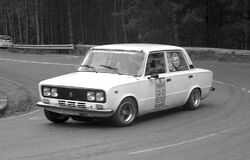
The SEAT 1430 in competition
SEAT's involvement in motorsport begins back in the '60s with the brand's contribution to the national formula races in Spain and by the end of the same decade the start of its implication to rallies.[73] In 1971, the 'Special Vehicles department' was formed with the mission to enforce the brand's participation in rally championships, followed by 11 titles between 1979 and 1983.[74] The year 1985 was the moment when SEAT Sport was founded as a separate motorsport division and especially since the Volkswagen Group takeover in 1986, SEAT has been increasing even more its presence in the motorsport world, mainly down to VW's plan on focusing the SEAT brand as 'sporty' in order to appeal particularly to the younger generation of drivers.[75] The result of this effort has been rewarded through SEAT's most prestigious titles in FIA championships, three conquests with the SEAT Ibiza Kit-Car in the FIA 2L World Rally Championship (WRC) (1996, 1997, 1998) and two times with the SEAT León in the FIA World Touring Car Championship (WTCC) (2008, 2009).[76]
Rallying[]
SEAT's first serious attempt at a World Rally Championship (WRC) was back in the 1977 season when SEAT took part with its 'SEAT 1430/124D Especial 1800' race car, and already in its debut rallying event at the Montecarlo Rally the SEAT team finished in the third and fourth place with the official 1430-1800 cars being driven by Antonio Zanini and Salvador Cañellas. In the recent years the consignment was burdened on the small SEAT Ibiza, a 1.6L normally aspirated front-wheel drive car with its roots in the Volkswagen Polo. The Ibiza allowed the company to further evolve its rallying experience, and was officially engaged in some European national championships. The years went by until a 2L version of the Ibiza was homologated as a kit-car, and extra wide tracks, larger wheels, brakes, etc., were fitted to it as the Fédération Internationale de l'Automobile (FIA) kit-car regulations allow. With these attributes, the car succeeded three times the 2L World Champion ('96, '97, '98), proving its maker had accumulated enough experience, and budgets, to take a chance at the reign category, the World Rally Car class of rallying cars.
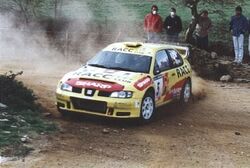
Daniel Solà with the SEAT Córdoba WRC at the Rallye de tierra de Cangas del Narcea
SEATs three conquests of the FIA 2L WRC title, and the sport's popularity in Spain, probably convinced Volkswagen Group management to go further and allow the SEAT Sport department a chance to reach its goal in the top class WRC category. This situation came to an end in September 2000, when the company's German upper management revoked its decision forcing SEAT Sport to retire from the World Rally Championship.
SEATs project to build a WRC-spec car was officially announced during the 1997 San Remo rally. It was in 1998 that the first evolution of the 'SEAT Córdoba WRC' car was presented at the Porto Motor Show and then first enrolled by the company to compete at the highest level of WRC racing. The Córdoba was based on the family saloon of the same name but was, naturally, a WRC class car equipped with a 4 cylinder turbocharged petrol engine, permanent four-wheel drive, and active differentials involved in its transmission. The 'Córdoba WRC' made its debut at the 1998 Rally of Finland, while a further development on the race car was incarnated on the 'SEAT Córdoba WRC E2' car which was presented at the Barcelona Motor Show in 1999. However, the short wheelbase and high-mounted engine (compared to its rivals) worked against the Córdoba, and results weren't top competing. Despite hiring ex-WRC champion Didier Auriol, and a new evolution of the car i.e. the 'SEAT Córdoba WRC E3', SEAT pulled out of international rallying at the end of 2000.
Touring cars[]
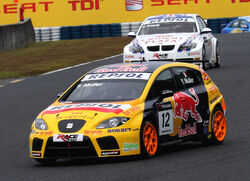
Yvan Muller with the SEAT León TDI in Japan
In 2002, SEAT announced a one-make championship for the new SEAT León Cupra R, the SEAT León Supercopa.
In 2004, SEAT with Ray Mallock Ltd. (RML) entered the British Touring Car Championship, running two SEAT Toledo Cupra for former-BTCC Champion Jason Plato, and 2003 León UK Champion, Rob Huff. In 2005, Huff left to join Chevrolet (run by RML in the World Touring Car Championship (WTCC)), and he was replaced by 2004 Leon Champion James Pickford, and Luke Hines as SEAT expanded to three cars, now run by Northern South. 2006 saw the Toledo replaced by the new León, and Darren Turner joined the team with James Thompson when his WTCC commitments allowed. 2007 was SEAT's best year in BTCC, as Plato was locked in a season-long battle with Fabrizio Giovanardi, which came down to the final race of the season, but just missed out on the title.
Since 2005, SEAT has also competed in the World Touring Car Championship, with its first best season being 2007, where a failed water pump robbed Yvan Muller of certain victory at the final meeting in Macau. SEAT became the first team to run a TDI in the WTCC and this gave them a dominant 2008 World Touring Car Championship season, with Yvan Muller wining the drivers championship. French racing team Oreca cooperates with the WTCC team. SEAT's UK team followed suit in the 2008 BTCC. The BTCC team was sponsored by Holiday Inn.
In 2007, SEAT – with the León Mk2 TDI at the Motorsport Arena Oschersleben in Germany – became the first manufacturer to win a round of the World Touring Car Championship (WTCC) series in a diesel car, only a month after announcing it will enter the FIA World Touring Car Championship with the León TDI. SEAT's success with the León TDI was continued, and resulted in winning consecutively 2008 World Touring Car Championship and 2009 World Touring Car Championship both titles (for drivers' as well as for manufacturers').
On the 11th September 2008 SEAT UK announced that it was to withdraw from all motor sport activity in the UK at the end of the season. The SEAT Cupra Championship and the SEAT BTCC campaign are to end at Brands Hatch on the 21st September. BTCC drivers Jason Plato and Darren Turner have been left without drives for 2009. But Plato will drive for Silverline Chevrolet.
At the opening of the 2009 WTCC, SEAT placed 1st, 2nd, 3rd, and 4th in both races in Brazil.[77] At the second meeting of the WTCC (in Mexico), the SEAT team placed 1st, 4th, 6th, 7th and 11th in the first race. The second race they placed 1st, 3rd, 7th, and 8th.[78] While SEAT may have withdrawn from the BTCC, they are showing impressive results in the WTCC.

The SEAT Cupra GT in the Spanish GT championship for the SunRED racing team
Grand tourer cars[]
In 2003 the SEAT Sport division presented at the Barcelona Motor Show first as a concept car and later the final version of the SEAT Cupra GT race car, which was produced in limited series on customer demand addressed to expertised individuals and racing teams willing to take part in race events.
The Cupra GT was chosen as a GT race car from racing teams, like the Sunred Engineering (SunRED) team, making its debut in 2004 in the Spanish GT Championship,[79] and took part in several Grand tourer circuits not only in Spain but also run in tracks abroad like those of Monza and Magny-Cours.[80]
Formula[]
In 1970 SEAT set up the 'Fórmula Nacional' series in Spain,[81][82] a year later to be known as 'Fórmula 1430'. The single seater formula cars, which took part driven by young Spanish drivers, were equipped under support from SEAT with engines of the 1430 model and 6700 gearboxes. The first race of the 'Fórmula Nacional' series took place at the Jarama circuit in Madrid.[6][83]
Model range[]
Nomenclature[]
SEAT's corporate tradition, as a Volkswagen Group subsidiary, has it that the nomenclature for a great number of models in its range gets inspired from the Spanish culture. For this purpose, a large number of SEAT's production models have been named after cities of Spain (e.g. Arosa, Ibiza, Córdoba, León, Toledo, Altea, Alhambra, Málaga, Marbella, Ronda etc.).[84] However there have been several cases where the denomination for a specific model did not derive directly from the Spanish heritage of the marque. As an example given making this exception, the name for the SEAT Exeo - the most recently added model to the brand's range - was influenced from the Latin word ‘exire’ which means 'to go beyond'.[85]
Following the marque's trend in production models, in many cases of concept cars too the names adopted were those either of Hispanic dances (e.g. Tango, Bolero, Salsa) or abbreviations still related to production models (e.g. IBZ for Ibiza, IBE for 'Ibiza Eléctrico',[86] TL for Toledo etc.) or even names reminiscent of SEAT's sporting roots in the past [76] (e.g. Fórmula, Cupra GT) .
Moreover in the recent years, there have been special versions in the production models' specific ranges carrying attachments such as SC (standing for SportCoupé [87]) or ST (for SportTourer [88]) discriminating relatively the 3-door and the estate versions from the standard 4/5-door ones, while the terms Cupra (for Cup Racing [89]) and FR (for Fórmula Racing [90]) have been used for the top-engine hardcore cars in the range, signalising SEAT's positioning as a sporty brand[6] involved in the racetracks.
As a reminder from the past also comes the iconic 'Bocanegra' name, meaning 'black mouth' in Spanish, which accompanies the Ibiza model and has its origins in the SEAT 1200 Sport, the original 'SEAT Bocanegra' due to its black painted fascia in the front.[91]
Sub-ranges[]
'Ecomotive' range
Almost every model in SEAT's range has an 'Ecomotive' derivative version, which in comparison to the standard version has a more eco-friendly tuning.[92]
Reduction of weight, low-resistance tyres, new aerodynamics, tweaks in the suspension,[93] as well as changes made to the engine's electronic management software with an additional implementation of a maintenance-free[94] Diesel Particle Filter (DPF) for the diesel engines, also updates in the gearbox and the gear ratios with a gearshift indicator in the dash panel reminding when it is the proper time to change gears, combined with an engine 'Start/Stop system' and an 'Energy Recuperation system' are some of the modifications adopted in the Ecomotive range in order to cut down both fuel consumption and emissions.[95] The result is a range with some of the cleanest models [96] featuring an improvement not only in gas and particles emissions but also in fuel economy, without big compromise in the vehicle's dynamic performance or practicality; for example the SEAT Ibiza Ecomotive 1.4 TDI has CO2 emissions coming up at 98 g/km [97] and still it comes even faster from 0 to 100 km/h than the standard version [98] featuring a 5-door body and air-conditioning , while the SEAT León Ecomotive's CO2 emissions are among the lowest in its segment too and raise up to 99 g/km.[99]
Up to the present, the Ecomotive range has been renowned in many occasions.
In 2008, the Ibiza Ecomotive has been declared on top of the Verkehrs-Club Deutschland’s 2008/2009 list in the “environmentally beneficial vehicle” category [100] and in the 10th Eco Tour not only it has won in the small diesel class but also proved to be the overall winner of all categories.[101] In that specific year the SEAT Ibiza Ecomotive was also awarded with the 'Ecobest 2008' award by the Autobest organisation [97] and the German newspaper Bild am Sonntag named it the 'most economic car of its class in the world'.[102]
The year 2009 has been the one when once more the Ibiza Ecomotive was nominated for the 'Green Steering wheel' award in Switzerland,[103] and has set two consecutive times a new world record on fuel saving with a single tank, certified by the IPMC (International Police Motor Corporation) : the first when the Austrian Gerhard Plattner drove from Martorell (Spain) to Göttingen (Germany) with an average fuel consumption of 2.9 l/100 km [104] and the second time in his route from Cieszyn (Poland) to Frankfurt (Germany) having achieved the world record in fuel consumption of 2,34 /100 km (or 100 mpg U.S.[105]) covering a distance of 1,910 km on a single tank.[106]
'MultiFuel' range
The MultiFuel range consists in the introduction of the flexible-fuel vehicle bio-ethanol technology in selected SEAT models - i.e. the SEAT León MultiFuel,[107] the SEAT Altea MultiFuel [108] and the SEAT Altea XL MultiFuel [109] - with the implementation of the 1.6 MPI MultiFuel E85 motor, capable of producing exactly the same horsepower (102 bhp) just like the relevant pure petrol version of the engine.
Current models[]
The company differentiates its own model range and styles its own models of cars in accordance with the development policies of the Volkswagen Group.
- Ibiza / Ibiza SC / Ibiza ST , currently in its fourth generation
- León , currently in its second generation
- Altea / Altea XL / Altea Freetrack
- Exeo / Exeo ST
- Alhambra , currently in its second generation
 The SEAT Ibiza, SEAT's best selling car |
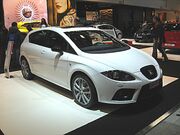 The SEAT León, SEAT's World Touring Car Champion |
 The SEAT Exeo, SEAT's aspect for a compact executive car went into production in December 2008 |
 The SEAT Alhambra, SEAT's large MPV was the first model to be produced in a non-Spanish plant since 1996 |
 SEAT Tarraco |
Sales and production figures[]
Since its beginnings in 1953, more than 16 million SEAT cars have been produced with the most successful product in the range being the SEAT Ibiza, a model which has sold over 4 million units in its four generations up to the present.[110]
In the year 2009, the total annual retail sales number of SEAT cars was 336,683 vehicles,[111] while the annual production of vehicles under the SEAT brand came up to 307,502 units (301,287 made in SEAT's Martorell plant and 6,215 in other Volkswagen group's factories).
The total production per year of SEAT cars, manufactured in SEAT and other Volkswagen group's plants, is shown in the following table (not comprising cars of other Volkswagen group's brands, produced in SEAT-owned facilities) :
| model | 1998 [112] |
1999 [112] |
2000 [113] |
2001 [114] |
2002 [115] |
2003 [116] |
2004 [117] |
2005 [118] |
2006 [119] |
2007 [120] |
2008 [121] |
2009 [122] |
2010 [123] |
|---|---|---|---|---|---|---|---|---|---|---|---|---|---|
| SEAT Marbella | 2,337 | — | — | — | — | — | — | — | — | — | — | — | — |
| SEAT Arosa | 38,338 | 46,410 | 28,403 | 22,980 | 19,627 | 13,814 | 9,368 | — | — | — | — | — | — |
| SEAT Ibiza / SEAT Ibiza SC / SEAT Ibiza ST | 180,775 | 194,245 | 199,279 | 188,427 | 197,311 | 220,497 | 183,754 | 168,645 | 183,848 | 172,206 | 192,470 | 173,715 | 189,083 |
| SEAT Inca | 17,226 | 19,221 | 16,328 | 15,207 | 11,802 | 7,982 | — | — | — | — | — | — | — |
| SEAT Inca Kombi | 7,708 | 8,573 | 5,534 | 5,316 | 3,879 | 2,150 | — | — | — | — | — | — | — |
| SEAT Córdoba / SEAT Córdoba Vario | 108,749 | 111,894 | 97,685 | 78,770 | 58,646 | 59,348 | 46,821 | 37,568 | 31,058 | 29,747 | 20,439 | 4,861 | — |
| SEAT León | — | 6,080 | 93,123 | 91,939 | 93,606 | 96,536 | 90,850 | 98,130 | 126,511 | 120,630 | 96,761 | 66,368 | 79,462 |
| SEAT Altea / SEAT Altea XL / SEAT Altea Freetrack | — | — | — | — | — | — | 67,125 | 65,174 | 58,288 | 71,377 | 54,770 | 32,791 | 43,351 |
| SEAT Toledo | 42,325 | 105,818 | 59,480 | 47,645 | 39,503 | 36,026 | 38,962 | 20,600 | 8,613 | 4,744 | 5,484 | 571 | — |
| SEAT Exeo / SEAT Exeo ST | — | — | — | — | — | — | — | — | — | — | 369 | 22,981 | 23,108 |
| SEAT Alhambra | 21,300 | 27,440 | 23,924 | 26,524 | 26,308 | 23,693 | 21,580 | 14,902 | 14,352 | 14,242 | 10,282 | 6,215 | 10,023 |
| Total annual production | 418,758 | 519,681 | 523,756 | 476,808 | 450,682 | 460,046 | 458,460 | 405,019 | 422,670 | 412,946 | 380,575 | 307,502 | 345,027 |
Rebadges[]
Under Volkswagen Group's ownership, numerous SEAT models have been rebadged under other brands, either inside the Volkswagen Group's portfolio or out of it.
In particular some examples, concerning the rebadges deriving from SEAT models and being carried out under other Volkswagen Group's brands, are the SEAT Ibiza Mk2 which has been rebadged under the VW brand as the VW Polo Playa, the SEAT Córdoba Mk1 rebadged as the VW Polo Classic - FAW-VW City-Golf - VW Derby, the SEAT Arosa as the VW Lupo, and the SEAT Inca as the VW Caddy.
Further rebadges have come under non Volkswagen Group brand ranges and some notable examples are the SEAT Ibiza Mk1 which has been rebadged as the Nanjing Yuejin Eagle NJ6400-Unique NJ6400-Soyat NJ7150-Soyat Unique NJ1020, and the SEAT Toledo Mk1 as the Chery A11-Fulwin-Fengyun-Windcloud - Chery A15-A168-Amulet-Cowin-Qiyun-Flagcloud - Vortex Corda .
On the other hand, several SEAT models have derived as rebadges coming from other Volkswagen Group's brands such as the SEAT Alhambra Mk1 and Mk2 respectively from the VW Sharan Mk1 and Mk2 (the first generation resulting after a joint venture of the Volkswagen Group together with Ford) and the SEAT Exeo from the Audi A4 B7.
Tuning companies[]
Several tuning companies have produced modified or high performance versions of various SEAT models, some significant examples among those being Abt Sportsline, Je Design, MTM (Motoren Technik Mayer), Abarth, Emelba, Annibal etc.
Earlier models[]
 SEAT 1200 Sport, 'Bocanegra',  SEAT 850 Spyder, 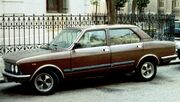 SEAT 132,
|
Concept models[]
 SEAT Tribu,  SEAT IBE concept,  SEAT Tango,
|
Future models[]
According to the president of SEAT James Muir in an interview to the Spanish daily newspaper El Mundo on October 2010,[124][125]
SEAT scheduling comprises the following future models in the near future
- SEAT city car
- SEAT León Mk3 (3-door/5-door/estate)
- SEAT small family car (Berlina segmento C rumoured to be the successor of the SEAT Toledo)
- SEAT Exeo Mk2
while there is still thinking of a compact MPV car successor to the Altea, and a SUV model on the basis of the SEAT IBX concept car.[126]
Company profile[]
Leadership[]
Today as a Volkswagen group's subsidiary, SEAT's leading people are appointed after approval from the group's supervisory board.
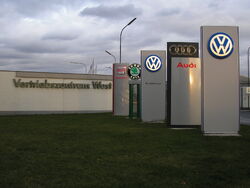
Volkswagen group's distribution centre in Germany
| from | to | person(s) |
|---|---|---|
| 1950 | May 1967 | José Ortiz Echagüe |
| May 1967 | February 1977 | Juan Sánchez Cortés |
| February 1977 | December 1983 | Juan Miguel Antoñanzas Pérez-Egea |
| January 1984 | September 1993 | Juan Antonio Díaz Álvarez |
| October 1993 | October 1993 | Peter Walzer |
| November 1993 | December 1996 | Juan Llorens Carrió |
| January 1997 | June 1999 | Pierre-Alain de Smedt |
| June 18, 1999 | June 30, 2000 | Bruno Adelt |
| July 1, 2000 | March 6, 2002 | Bernd Pischetsrieder |
| March 7, 2002 | September 30, 2006 | Andreas Schleef |
| October 1, 2006 | 31 August 2009 | Erich Schmitt |
| 1 September 2009 | present | James Muir |
Economic figures[]
| Year | After-tax result (in millions of euros) |
|---|---|
| 1996 | +32.088 |
| 1997 | +66.418 |
| 1998 | +147.020 |
| 1999 | +85.403 |
| 2000 | +87.348 |
| 2001 | +233.121 |
| 2002 | +202.965 |
| 2003 | +134.494 |
| 2004 | +144.957 |
| 2005 | -62.513 |
| 2006 | -49.088 |
| 2007 [127] | +169.703 |
| 2008 [128] | +44.400 |
| 2009 [129] | -186.500 |
| 2010 [130] | -103.900 |
Environmental policy[]
‘SEAT al Sol’ project
The ‘SEAT al Sol’ project consists in the integration of use of solar power through a system of photovoltaic panels generating electricity in SEAT's factory in Martorell. The project is going to be carried through in collaboration with GA-Solar from the beginnings of 2010, covering a factory area of 320,000 m2 with a system of more than 10 MW of photovoltaic panels. This installation is expected to produce more than 13 million kwh of electricity annually, aimed at reducing greenhouse gas emissions by over 6,200 tonnes of CO2 per year.[131][132]
'Cenit verde' project
The Cenit VERDE initiative is a research project backed by the CENIT (the National Strategic Consortia for Technical Research) programme and supported by the Spanish Ministry of Science and Innovation, in which SEAT plays a key role. Aiming at developing technologies, components and infrastructure for hybrid and electrically-powered cars in Spain, this programme brings together 16 technology companies (including Siemens, Endesa, Iberdrola, REE, Cegasa, Ficosa, Circuitor, Cobra or Lear) and 16 universities and research establishments under the CTM coordination (Centre Tecnològic in Manresa) [133] and the support of the CDTI (Centre for Industrial Technological Development, an organization pertaining to the Ministry of Science and Innovation) .
In January 2010, the Cenit Verde association made its opening meeting at SEAT's Technical Centre in Martorell.[134]
As part of its contribution SEAT comes in with its own 'Verde' pre-project, including the technology implemented in the plug-in hybrid SEAT León Twin drive [135] as well as in the SEAT IBE concept zero emissions electric vehicle presented in the 2010 Geneva motor show.[136]
'SEAT Autometro' project

A TMD (Teco Media Distancia) cargo train on its way from SEAT's Martorell plant [137]
The 'SEAT Autometro' project comprises the construction and management of a rail link service between the SEAT's Martorell complex and the Port of Barcelona, in the aim of transport of vehicles and components. Autometro is the joint-venture company which operates the rail, having Ferrocarrils de la Generalitat de Catalunya (FGC) local rail company, COMSA Rail Transport and Pecovasa as its shareholders. The company was founded in November 2005 almost five months after an initial agreement was signed between the Catalan government (Generalitat), the Barcelona Port Authority and SEAT.[138] Due to this project, a branch connecting the Martorell plant with the FGC 'Llobregat-Anoia' main rail line had to be constructed, as well as further adaptations to the transport network and the host infrastructures in the Port of Barcelona had to be made. The budget for the project comes up to 6.8 million euro, while SEAT on its part also assumes the operational transport costs.[139]
The use of this rail link since January 18, 2008, instead of road transport, has helped not only in terms of cost effectiveness and road safety but also in the reduction of both road congestion and greenhouse gas emissions.
Over the whole 'Autometro' project awards have been given for the best logistics idea at the 2007 International Logistics Fair (SIL) and specifically to SEAT as the 2008 Distinguished loader by the Loaders’ Association of the Port of Barcelona.[140]
Sponsorship[]
SEAT has been a sponsor in major sports events, such as
- UEFA Europa League [141]
- Red Bull Air Race World Championship [142]
- Davis Cup World Group Final [143]
- Barcelona 1992 Olympic games [144][145]
and a strong supporter to artists, like Shakira,[146] Armin van Buuren,[147] David Guetta[148][149] etc.
Awards[]
Over the years the SEAT marque has been honoured with several awards, such as
- The Landaben plant, 100% owned by SEAT, S.A. by that time , received in 1986 the World quality award (Q-86).[150]
- The Martorell plant, 100% owned by SEAT, S.A. , received in 1998 the Best factory of the VW Group in the first quarter award.
- The Barcelona 'Gearbox del Prat' plant, 100% owned by SEAT, S.A. , received in 2009 the Volkswagen Excellence award for its high-quality manufacturing process and product.[27]
- The SEAT brand itself in 2009 has been named 'Most Improved Used Car Brand of the decade' in the CAP Used Car of the Decade Awards.[151][152]
- 'AvD Innovationspreis 2006' award for technological innovations developed at the SEAT Technical Centre in Martorell, from the German automobile club 'Automobilclub von Deutschland' (AvD) [153]
- In the 2007 Barcelona International motor show SEAT received two awards for the best technological innovations in the automotive sector, for the LED modules implementation in headlights and the project of virtual fabrication and applied ergonomics.[154][155]
- 'Best project in the use of an electronic signature in the private sector in 2008' for SEAT’s electronic invoicing system, by the Catalan Certification Agency (CATCert) [156]
- 'Best logistics initiative 2007' award for the SEAT-Autometro project, by the International Logistics Salon [157]
- 'Port of Barcelona’s Distinguished Loader prize in 2008' , by the Port of Barcelona’s Loaders’ Association [158]
References[]
| This page uses some content from Wikipedia. The original article was at SEAT. The list of authors can be seen in the page history. As with Tractor & Construction Plant Wiki, the text of Wikipedia is available under the Creative Commons by Attribution License and/or GNU Free Documentation License. Please check page history for when the original article was copied to Wikia |
- ↑ "legal note". SEAT.com. Retrieved on 2010-09-25.
- ↑ "> 1979-1950". SEAT.com. Retrieved on 2010-03-09.
- ↑ Audi Brand Group http://www.volkswagenag.com/vwag/gb2006/content/en/Divisions/Audi_Brand_Group.html
- ↑ 4.0 4.1 4.2 4.3 "SEAT hoy". Media.seat.com (2009-03-23). Retrieved on 2010-03-11.
- ↑ SEAT celebrates 60 years http://media.seat.com/en/company/60th-anniversary/609-seat-cumple-60-anos.html
- ↑ 6.0 6.1 6.2 SEAT is the youthful and sporty car maker from Spain http://media.seat.com/en/seat-news/597-nuevo-seat-alhambra-mas-funcional-y-eficiente.html
- ↑ SEAT Annual report 2008 http://www.volkswagenag.com/vwag/vwcorp/info_center/en/publications/2009/03/Seat_Annual_Report_2008.-bin.acq/qual-BinaryStorageItem.Single.File/Seat_AnnualReport2008.pdf
- ↑ "SEAT produces car number 16 million since its beginnings". Media.seat.com (2008-01-25). Retrieved on 2010-03-08.
- ↑ SEAT is exporting approximately 75% of its production to 72 countries http://www.seat.com/com/generator/su/com/SEAT/site/company/annualReport/main.html
- ↑ SEAT facts http://www.seat.com/com/generator/su/com/SEAT/site/company/facts/main.html
- ↑ Martorell plant 15-years of activity celebrations http://media.seat.com/en/seat-news/2005/238.html
- ↑ Viaintermedia. "PV solar - your source for renewable energy news– solar, wind, biomass, biofuel, hydro, CO2, solar thermal, hydro power, climate change, carbon trading". Renewable Energy Magazine. Retrieved on 2010-03-08.
- ↑ "SEAT begins rail transport between Martorell and Zona Franca". Media.seat.com. Retrieved on 2010-03-08.
- ↑ "SEAT Sport". Media.seat.com (2009-03-21). Retrieved on 2010-03-08.
- ↑ "> Visions + Innovation". SEAT.com. Retrieved on 2010-03-08.
- ↑ "SEAT Design Center". Media.seat.com (2009-03-26). Retrieved on 2010-03-08.
- ↑ "Prototypes Centre of Development". Media.seat.com (2009-03-27). Retrieved on 2010-03-08.
- ↑ SEAT Service http://media.seat.com/en/company/379-seat-service.html
- ↑ "Genuine Parts Centre". Media.seat.com (2009-03-25). Retrieved on 2010-03-08.
- ↑ Audi MediaServices - AUDI AG: New Q3 SUV generation to be produced in Martorell, Spain as of 2011
- ↑ "Martorell Factory". Media.seat.com (2009-03-29). Retrieved on 2010-03-08.
- ↑ Bernhard opposes Seat sale http://www.autonews.com/apps/pbcs.dll/article?AID=/20061205/SUB/312050002
- ↑ The A3 five-door version is design engineered at Seat http://www.autonews.com/article/20030901/GERMANNEWSLETTER/309010778
- ↑ Seat to develop Q5 and a subcompact for Audi http://www.autonews.com/article/20060911/GERMAN_NEWSLETTER/60911011
- ↑ Martorell plant preparations for the Audi Q3 http://media.seat.com/en/seat-news/2009/440-seat-inicia-las-obras-del-taller-que-producira-el-audi-q3-en-2011.html
- ↑ "El Centro de Formación de SEAT cumple 50 años". Media.seat.com. Retrieved on 2010-03-08.
- ↑ 27.0 27.1 27.2 "Gearbox del Prat". Media.seat.com (2009-03-23). Retrieved on 2010-03-08.
- ↑ "Seat Historia". Autopasion18.com. Retrieved on 2010-03-08.
- ↑ Volkswagen AG: Signing the contract with SEAT http://www.volkswagenag.com/vwag/vwcorp/info_center/en/themes/2010/05/seat_celebrates_60_years/signing_the_contract_with_seat.html
- ↑ "Seat Anno Per Anno". Carulli.com. Retrieved on 2010-03-08.
- ↑ SEAT paints 4,600 VW Polo in Martorell. http://media.seat.com/en/seat-news/2007/47.html
- ↑ SEAT's plant in Martorell reassumes 100% of the Ibiza production http://media.seat.com/en/seat-news/2004/208.html
- ↑ "SEAT chooses Barcelona for eco-friendly vehicle innovation centre". Media.seat.com. Retrieved on 2010-03-10.
- ↑ Descubrimos los secretos de la Nave A122 http://www.motor16.com/pagina/Interesante/60/anos/Seat/53/1134/0/30/35/0/2/32
- ↑ Seat y su apuesta por la recuperación de la memoria histórica http://www.actionpress.net/clasicos/?p=1440
- ↑ "SEAT IT-Services". Seat-it-services.de. Retrieved on 2010-03-16.
- ↑ Autostadt site http://www.autostadt.de/
- ↑ SEAT Pavilion at the Autostadt http://www.seat.com/com/generator/su/com/SEAT/site/events/autostadt/main,lang=es.html
- ↑ "SEAT de México". Seat-mexico.com.mx. Retrieved on 2010-11-14.
- ↑ Seat desembarcará en China el año que viene http://www.europapress.es/catalunya/noticia-seat-desembarcara-china-2012-20110310130831.html
- ↑ Seat prepara su entrada en China http://www.elmundo.es/elmundomotor/2011/03/10/empresa/1299758967.html
- ↑ VW's SEAT casts an eye toward U.S. market http://www.autonews.com/apps/pbcs.dll/article?AID=/20050509/SUB/505090793
- ↑ "SEAT South Africa – Home". Seatsa.co.za. Retrieved on 2009-04-27.
- ↑ "VW shock: SEAT to quit SA: Wheels: News: Industry_News". Wheels24.co.za. Retrieved on 2010-03-08.
- ↑ World motor vehicle production by country and type http://oica.net/wp-content/uploads/all-vehicles-2010-provisional.pdf
- ↑ World's 20 largest producers of cars http://www.rediff.com/business/slide-show/slide-show-1-auto-india-set-to-be-6th-among-worlds-20-largest-car-producers/20110323.htm
- ↑ S. Estapé-Triay. State and industry in the '40s: The Spanish automobile industry. Department of Economics and Business - Universitat Pompeu Fabra - Barcelona, 1999, p. 8-11
- ↑ S. Estapé-Triay. State and industry in the '40s: The Spanish automobile industry. Department of Economics and Business - Universitat Pompeu Fabra - Barcelona, 1999, p. 23
- ↑ Seat: kilómetros más cortos http://www.autobild.es/reportajes/seat-kil%C3%B3metros-m%C3%A1s-cortos
- ↑ Historia de la SEAT http://www.historiaseat.com/kinex-fr.htm
- ↑ SEAT history 1950-1979 http://www.seat-mexico.com.mx/seatmx/c/MX/es/home_page/inicio_/historia/50_aniversario.html
- ↑ El coche como símbolo del declive http://www.abc.es/hemeroteca/historico-14-11-2008/abc/Opinion/el-coche-como-simbolo-del-declive_911233353595.html
- ↑ Seat 600 How Spain got taste for navel gazing http://www.independent.co.uk/life-style/motoring/features/seat-600-764027.html
- ↑ El Centro de Formación de SEAT cumple 50 años http://media.seat.com/en/seat-news/2007/19.html?g2_language=en_GB
- ↑ "News and Views: Fiat control Seat", Autocar 126 (nbr 3702): 46. date 26 January 1967.
- ↑ La obra del arquitecto Coderch, expuesta en Madrid http://www.elpais.com/articulo/cultura/CODERCH/_JOSE_ANTONIO/MADRID/MADRID_/MUNICIPIO/obra/arquitecto/Coderch/expuesta/Madrid/elpepicul/19890218elpepicul_5/Tes?print=0
- ↑ 57.0 57.1 "Motorweek: Car losses hit SEAT", Motor nbr 3640: page 56. date 22 April 1972.
- ↑ Indugasa invierte 780 millones en Galicia http://www.elpais.com/articulo/economia/GALICIA/INDUSTRIAS_MECANICAS_DE_GALICIA/_SA/Indugasa/invierte/780/millones/Galicia/elpepieco/19780623elpepieco_11/Tes
- ↑ Authi history http://www.aronline.co.uk/index.htm?authiindexf.htm
- ↑ Investigaciones de Historia Económica (IHE) Journal of the Spanish Economic History Association, 2007, vol. 9, pages 141-172
- ↑ "News: SEAT to build Lancias", Autocar: page 24. date 14 August 1976.
- ↑ Seat y Toyota pueden haber llegado ya a un acuerdo de principio http://www.elpais.com/articulo/economia/TOYOTA/SEAT/Seat/Toyota/pueden/haber/llegado/acuerdo/principio/elpepieco/19810901elpepieco_7/Tes
- ↑ SEAT (1950...) http://www.autopasion18.com/HISTORIA-SEAT.htm
- ↑ SEAT 1980-1990 http://www.seat.com/com/generator/su/com/SEAT/site/company/history/1989-1980/main.html
- ↑ SEAT&VW group partnership agreement http://media.seat.com/en/component/g2bridge/26/?g2_itemId=22665&option=com_g2bridge
- ↑ SEAT Hoy
- ↑ El Centro de Diseño de Sitges, inaugurado en 1994 http://www.libertaddigital.com/economia/seat-vende-al-ayuntamiento-de-sitges-su-centro-de-diseno-en-esta-localidad-1276272894/
- ↑ Volkswagen's branding plan takes shape http://www.autonews.com/apps/pbcs.dll/article?AID=/20011203/ANE/112030837
- ↑ Volkswagen Group - Business lines and markets http://www.volkswagenag.com/vwag/gb2006/content/en/Divisions/Business_Lines_and_Markets.html
- ↑ http://www.volkswagenag.com/vwag/vwcorp/info_center/en/publications/2002/03/list_of_holdings01.-bin.acq/qual-BinaryStorageItem.Single.File/20011231_anteilsbesitz_e.pdf
- ↑ http://www.sitgesmodelxxi.cat/media/51/CentreDissenySitges2.pdf
- ↑ Keeping Gaudi's creative spirit alive http://www.volkswagenag.com/vwag/gb2007/content/en/driving_ideas/innovation/keeping_gaudi_s_creative_spirit_alive.html
- ↑ SEAT history in motorsport http://www.seat-mexico.com.mx/seatmx/c/MX/es/home_page/inicio_/historia/historia_deportiva.html
- ↑ SEAT motorsport 1970-1977 http://www.seat.com/com/generator/su/com/SEAT/site/company/SEATSport/main.html
- ↑ SEAT Sport http://media.seat.com/en/company/382-seat-sport.html
- ↑ 76.0 76.1 SEAT Sport history http://www.seat.com/com/generator/su/com/SEAT/site/company/SEATSport/main.html
- ↑ "Spectacular double 1-2-3-4 for SEAT in Brazil". Media.seat.com. Retrieved on 2009-04-27.
- ↑ "SEAT continues on winning streak in Mexico with Muller and Rydell". Media.seat.com. Retrieved on 2009-04-27.
- ↑ In 2004, the SEAT Cupra GT made its debut at the Spanish GT Championship http://www.seat-sport.com/en/compania/seat-competicion.php
- ↑ Complete Archive of Seat Cupra GT http://www.racingsportscars.com/type/archive/Seat/Cupra%20GT.html
- ↑ SEAT: The roots of racing http://www.seat.com/com/generator/su/com/SEAT2003-2008/site/company/history/sports/main,lang=en.html#article1
- ↑ De la Fórmula Nacional al Rallye de Montecarlo http://archivo.marca.com/automovilismo/rallyes/seat.html
- ↑ In 1970 the beginning of the so-called "Fórmula Nacional" was announced http://www.seat-sport.com/en/compania/seat-competicion.php
- ↑ Seat names big saloon ‘Exeo’ http://www.autocar.co.uk/News/NewsArticle/AllCars/233502/
- ↑ SEAT’s new saloon will be called “EXEO” http://media.seat.com/en/seat-news/2008/329-la-nueva-berlina-de-seat-se-llamara-exeo.html
- ↑ El SEAT IBE camino de la producción http://es.autoblog.com/2010/03/08/el-seat-ibe-camino-de-la-produccion/
- ↑ SEAT Ibiza SC http://www.seat.com/com/generator/su/com/newIbiza08SC/site/start/main.html
- ↑ SEAT Exeo ST http://www.seat.com/com/generator/su/com/ExeoST/site/start/main.html
- ↑ SEAT Ibiza Cupra http://www.seat.com/com/generator/su/com/NewIbizaCUPRA/site/history/main.html
- ↑ SEAT launches Formula Racing brand http://www.carenthusiast.com/reviews.html?mode=article&id=205
- ↑ New SEAT Ibiza Bocanegra http://media.seat.com/en/seat-news/2009/405-edicion-para-coleccionistas.html
- ↑ SEAT Ecomotive range http://www.seat.com/com/generator/su/com/SEAT/site/company/ecomotive/main.html
- ↑ SEAT Ibiza Ecomotive road test by AutoExpress http://www.autoexpress.co.uk/carreviews/grouptests/245245/seat_ibiza_ecomotive.html
- ↑ New SEAT Ibiza Ecomotive http://green.autoblog.com/2007/09/11/seat-announces-green-ibiza-ecomotive/
- ↑ SEAT Ecomotive range leaflet http://www.seat.com/static/su/com/SEAT/site/2009/ecomotive/downloads/PDF/Range_Leaflet_Ecomotive.pdf
- ↑ SEAT receives the Ecobest 2008 award http://media.seat.com/en/seat-news/2009/286-seat-recibe-en-estambul-el-premio-ecobest-2008-.html
- ↑ 97.0 97.1 The new SEAT Ibiza Ecomotive receives the Ecobest 2008 award http://media.seat.com/en/seat-news/2008/306-el-nuevo-ibiza-ecomotive-se-hace-con-el-ecobest-2008.html
- ↑ SEAT Ibiza Ecomotive site http://www.seat.com/com/generator/su/com/newIbiza08SC/site/versions/ecomotive/main.html
- ↑ SEAT delivers 500 Leons Ecomotive to British Gas http://media.seat.com/en/seat-news/563-seat-entrega-500-unidades-del-leon-ecomotive-a-british-gas.html
- ↑ The SEAT Ibiza Ecomotive is the most ecological car of the world in Germany http://media.seat.com/en/seat-news/2008/321-el-ibiza-ecomotive-vehiculo-mas-ecologico-en-alemania.html
- ↑ The SEAT Ibiza Ecomotive is the most economical car in the Eco tour 2008 http://media.seat.com/en/seat-news/2008/318-el-ibiza-ecomotive-vehiculo-mas-economico-en-el-eco-tour-2008.html
- ↑ The Bild newspaper names the Ibiza the most economic car of its class in the world http://www.bild.de/BILD/auto/bams/2008/11/seat-ibiza-ecomotive/das-sparsamste-auto-der-welt-im-test.html
- ↑ SEAT Ibiza Ecomotive nominated for the 'Green Steering wheel' award http://media.seat.com/en/seat-news/2009/498-el-seat-exeo-gana-el-volante-de-oro-2009-en-suiza.html
- ↑ 2.9 l/100 km world record for the Ibiza http://media.seat.com/en/seat-news/2009/404-el-ibiza-ecomotive-consigue-un-consumo-record-de-29-l100-km.html
- ↑ Austrian beats his own record with the Ibiza Ecomotive http://green.autoblog.com/2009/09/30/austrian-hyper-miler-beats-his-own-record-when-driving-a-seat-ib/
- ↑ Second world fuel-saving record of 2.34 l/100 km for the Ibiza http://media.seat.com/en/seat-news/2009/496-nuevo-record-de-consumo-para-el-ibiza-ecomotive-234-l100-km.html
- ↑ SEAT León MultiFuel http://www.seat.se/se/generator/su/se/newLeon09/site/versions/multifuel/main.html
- ↑ SEAT Altea MultiFuel http://www.seat.se/se/generator/su/se/altea09/site/versions/multifuel/main.html
- ↑ SEAT Altea XL MultiFuel http://www.seat.se/se/generator/su/se/AlteaXL09/site/versions/multifuel/main.html
- ↑ SEAT IBIZA A success story spanning 25 years http://media.seat.com/en/seat-news/2009/410-25-anos-de-exito.html
- ↑ 111.0 111.1 SEAT, S.A. Key Figures (2005 / 2009) http://media.seat.com/en/company.html
- ↑ 112.0 112.1 "Volkswagen AG Annual Report 1999". Volkswagen AG (2010-09-13). Retrieved on 2010-09-13.
- ↑ Volkswagen AG Annual Report 2000 http://www.volkswagenag.com/vwag/vwcorp/info_center/en/publications/2001/03/Annual_Report_2000.-bin.acq/qual-BinaryStorageItem.Single.File/VW_GB_2000_e.pdf
- ↑ Volkswagen AG Annual Report 2001 http://www.volkswagenag.com/vwag/vwcorp/info_center/en/publications/2002/03/annual_report_2001.-bin.acq/qual-BinaryStorageItem.Single.File/20020312_GB_2001_e.pdf
- ↑ Volkswagen AG Annual Report 2002 http://www.volkswagenag.com/vwag/vwcorp/info_center/en/publications/2003/03/annual_report_2002.-bin.acq/qual-BinaryStorageItem.Single.File/vw_gb_2002_en.pdf
- ↑ Volkswagen AG Annual Report 2003 http://www.volkswagenag.com/vwag/vwcorp/info_center/en/publications/2004/03/annual_report_2003.-bin.acq/qual-BinaryStorageItem.Single.File/20040309_gb2003_e.pdf
- ↑ Volkswagen AG Annual Report 2004 http://www.volkswagenag.com/vwag/vwcorp/info_center/en/publications/2005/03/annual_report_2004.-bin.acq/qual-BinaryStorageItem.Single.File/Gbericht_2004_en.pdf
- ↑ Volkswagen AG Annual Report 2005 http://www.volkswagenag.com/vwag/vwcorp/info_center/en/publications/2006/03/Volkswagen_AG__Annual_Report_2005.-bin.acq/qual-BinaryStorageItem.Single.File/gesch%C3%A4ftsbericht_2005_english.pdf
- ↑ Volkswagen AG Annual Report 2006 http://www.volkswagenag.com/vwag/vwcorp/info_center/en/publications/2007/03/Geschaeftsbericht_2006.-bin.acq/qual-BinaryStorageItem.Single.File/Annual_Report_2006_e.pdf
- ↑ Volkswagen AG Annual Report 2007 http://www.volkswagenag.com/vwag/vwcorp/info_center/en/publications/2008/03/Annual_Report_2007.-bin.acq/qual-BinaryStorageItem.Single.File/VW_AG_GB_2007_en.pdf
- ↑ Volkswagen AG Annual Report 2008 http://www.volkswagenag.com/vwag/vwcorp/info_center/en/publications/2009/03/GB_2008.-bin.acq/qual-BinaryStorageItem.Single.File/Y_2008_e.pdf
- ↑ Volkswagen AG Annual Report 2009 http://www.volkswagenag.com/vwag/vwcorp/info_center/en/publications/2010/03/Annual_Report_2009.-bin.acq/qual-BinaryStorageItem.Single.File/Y_2009_e.pdf
- ↑ Volkswagen AG Annual Report 2010 http://www.volkswagenag.com/vwag/vwcorp/info_center/en/publications/2011/03/Volkswagen_AG_Geschaeftsbericht_2010.-bin.acq/qual-BinaryStorageItem.Single.File/GB_2010_e.pdf
- ↑ SEAT will present in Geneva its new sedan http://es.autoblog.com/2010/10/11/seat-presentara-su-nuevo-sedan-compacto-en-ginebra-y-otras-jugo/
- ↑ Piccione, Sergio (October 9, 2010), "Tengo cinco años para hacer de Seat un motor del Grupo VW", El Mundo (Madrid: Unidad Editorial Información General) (7.599): 35
- ↑ SEAT IBX Concept Car – the young, dynamic and useful crossover http://media.seat.com/en/seat-news/750-seat-ibx-un-crossover-joven-dinamico-y-de-gran-utilidad.html
- ↑ SEAT Annual Report 2007 http://media.seat.com/info2008/annualreport/default.html
- ↑ SEAT Annual Report 2008 http://media.seat.com/info2009/annualreport/index.html
- ↑ SEAT Annual Report 2009 http://media.seat.com/info2010/annualreport/index.html
- ↑ Annual Report 2010 http://media.seat.com/info2010/annualreport-en/index.html
- ↑ "SEAT’s Martorell factory becomes a benchmark for renewable energy production". media.seat.com/en. Retrieved on 2010-09-25.
- ↑ SEAT To Build 10-MW Solar PV System http://www.renewableenergyworld.com/rea/news/article/2009/11/car-manufacturer-to-build-10-mw-solar-pv-system
- ↑ Starts up of Cenit verde, the spanish consortium dedicated to the development of the electric vehicle http://www.endesa.es/Portal/en/press/press_releases/our_companies/endesa/2010/20100114_1.htm
- ↑ The electric car in Spain gets green light http://media.seat.com/en/seat-news/548-arranca-el-vehiculo-electrico-en-espana.html
- ↑ SEAT, a major presence at meeting of Europe’s Industry Ministers http://media.seat.com/en/seat-news/557-seat-protagonista-de-la-reunion-europea-de-ministros-de-industria.html
- ↑ The young sports car for the electric age http://media.seat.com/en/salones/571-un-deportivo-para-la-era-electrica.html
- ↑ Cargometro: nuevo servicio de mercancías para Seat entre Barcelona y Martorell http://www.vialibre-ffe.com/noticias.asp?not=3701&cs=oper
- ↑ The first FGC SEAT train reaches the Port of Barcelona http://media.seat.com/en/seat-news/2008/16-llegada-del-primer-tren-de-fgc-de-seat-al-puerto-de-barcelona.html
- ↑ More than 63,300 vehicles transported between SEAT and Port of Barcelona http://media.seat.com/en/seat-news/2009/290-mas-de-63300-vehiculos-transportados-entre-seat-y-el-port.html
- ↑ SEAT awarded Port of Barcelona’s Distinguished Loader 2008 prize http://media.seat.com/en/seat-news/2008/324-el-port-de-barcelona-nombra-a-seat-cargador-destacado-2008.html
- ↑ SEAT sponsors the UEFA Europa League http://media.seat.com/en/seat-news/2009/480-seat-patrocinador-de-la-uefa-europa-league.html
- ↑ SEAT sponsors the Red Bull Air Race World Championship http://media.seat.com/en/seat-news/2009/281-seat-seguira-en-2009-como-patrocinador-de-la-red-bull-air-race.html
- ↑ SEAT sponsors the Davis Cup World Group Final http://media.seat.com/en/seat-news/2009/534-seat-vehiculo-oficial-de-la-final-de-la-copa-davis-de-tenis.html
- ↑ SEAT Ibiza is the official car of the Olympic games http://media.seat.com/en/seat-news/2009/410-25-anos-de-exito.html
- ↑ SEAT becomes a partner and a sponsor in the 1992 Olympic games http://media.seat.com/en/company/368-seat-hoy.html
- ↑ SEAT and Shakira start their collaboration with a digital animated TV spot http://media.seat.com/en/seat-news/556-seat-y-shakira-inician-su-colaboracion-con-un-spot-de-animacion-digital-.html
- ↑ SEAT & Armin van Buuren successful with marathon radio show http://media.seat.com/en/seat-news/2009/400-seat-y-armin-van-buuren-juntos-para-celebrar-una-maratoniana-emision-de-radio.html
- ↑ SEAT Ibiza SC by David Guetta http://carscoop.blogspot.com/2008/10/matte-black-seat-ibiza-sportcoupe-by.html
- ↑ David Guetta attends the David Guetta Seat Ibiza SC Launch Party at the Lido Cabaret in Paris http://www.life.com/image/83375532
- ↑ La fábrica de Landaben recibió el Premio Mundial de Calidad (Q-86) http://www.vw-navarra.es/fabrica/historia_desarrollo.aspx
- ↑ "Seat Named Most Improved Used Car Brand Of The Decade". European Motor News (2009-12-16). Retrieved on 2010-03-08.
- ↑ "SEAT". VAG Division. Retrieved on 2010-03-08.
- ↑ Award for SEAT's technological innovation http://media.seat.com/en/seat-news/2006/119.html
- ↑ SEAT gets two prizes for the best innovations in the sector http://media.seat.com/en/seat-news/2007/53.html
- ↑ SEAT innovates http://www.autoreview.it/articolo.php?a_id=1639
- ↑ SEAT is awarded for its electronic invoicing system http://media.seat.com/en/seat-news/2008/302-seat-premiada-por-su-sistema-de-facturacion-electronica-.html
- ↑ SEAT receives the best logistics initiative 2007 award http://media.seat.com/en/seat-news/2007/57.html
- ↑ "SEAT awarded Port of Barcelona’s Distinguished Loader 2008 prize". Media.seat.com. Retrieved on 2010-03-08.
External links[]
- SEAT.com corporate website
- SEAT Sport UK
- LeonOC.com Leon Owners Club
| |||||||||||||||||||||||||||||||||||||||||||||||
| |||||||||||||||||||||||
| SEAT car timeline, 1950s–1980s — a marque of the Volkswagen Group since 1986 — next » | |||||||||||||||||||||||||||||||||||||||||
|---|---|---|---|---|---|---|---|---|---|---|---|---|---|---|---|---|---|---|---|---|---|---|---|---|---|---|---|---|---|---|---|---|---|---|---|---|---|---|---|---|---|
| type / class |
1950s | 1960s | 1970s | 1980s | |||||||||||||||||||||||||||||||||||||
| 0 | 1 | 2 | 3 | 4 | 5 | 6 | 7 | 8 | 9 | 0 | 1 | 2 | 3 | 4 | 5 | 6 | 7 | 8 | 9 | 0 | 1 | 2 | 3 | 4 | 5 | 6 | 7 | 8 | 9 | 0 | 1 | 2 | 3 | 4 | 5 | 6 | 7 | 8 | 9 | ||
| city car | 600 | 133 | |||||||||||||||||||||||||||||||||||||||
| 800 | Panda | Marbella | |||||||||||||||||||||||||||||||||||||||
| supermini | 127 | Fura | |||||||||||||||||||||||||||||||||||||||
| 850 | 1200 Sport | Ibiza I | |||||||||||||||||||||||||||||||||||||||
| small family car | 128 | Málaga | |||||||||||||||||||||||||||||||||||||||
| Ritmo | Ronda | ||||||||||||||||||||||||||||||||||||||||
| mid- size car |
124 | ||||||||||||||||||||||||||||||||||||||||
| 1430 | 131 | ||||||||||||||||||||||||||||||||||||||||
| large family car | 1400 | 1500 | 132 | ||||||||||||||||||||||||||||||||||||||
| panel van | Trans | Terra | |||||||||||||||||||||||||||||||||||||||
| founder: Instituto Nacional de Industria • SEAT corporate website • A marque of the Volkswagen Group | |||||||||||||||||||||||||||||||||||||||||
| « previous — SEAT car timeline, 1980s–present — a marque of the Volkswagen Group since 1986 | ||||||||||||||||||||||||||||||||
|---|---|---|---|---|---|---|---|---|---|---|---|---|---|---|---|---|---|---|---|---|---|---|---|---|---|---|---|---|---|---|---|---|
| type / class |
1980s | 1990s | 2000s | 2010s | ||||||||||||||||||||||||||||
| 0 | 1 | 2 | 3 | 4 | 5 | 6 | 7 | 8 | 9 | 0 | 1 | 2 | 3 | 4 | 5 | 6 | 7 | 8 | 9 | 0 | 1 | 2 | 3 | 4 | 5 | 6 | 7 | 8 | 9 | 0 | 1 | |
| city car | Arosa | |||||||||||||||||||||||||||||||
| Panda | Marbella | |||||||||||||||||||||||||||||||
| supermini | 127 | Fura | ||||||||||||||||||||||||||||||
| Ibiza I | Ibiza II | Ibiza III | Ibiza IV | |||||||||||||||||||||||||||||
| small family car | 128 | Málaga | Córdoba I | Córdoba II | ||||||||||||||||||||||||||||
| Ritmo | Ronda | León I | León II | |||||||||||||||||||||||||||||
| mid-size car | 124 | |||||||||||||||||||||||||||||||
| 131 | Toledo I | Toledo II | Toledo III | |||||||||||||||||||||||||||||
| large family car | 132 | Exeo / Exeo ST | ||||||||||||||||||||||||||||||
| compact MPV | Altea | |||||||||||||||||||||||||||||||
| Altea XL | ||||||||||||||||||||||||||||||||
| Altea Freetrack | ||||||||||||||||||||||||||||||||
| large MPV | Alhambra I | Alhambra II | ||||||||||||||||||||||||||||||
| panel van | Trans | Terra | Inca | |||||||||||||||||||||||||||||
| founder: Instituto Nacional de Industria • SEAT corporate website • A marque of the Volkswagen Group • SEAT Cupra Challenge | ||||||||||||||||||||||||||||||||